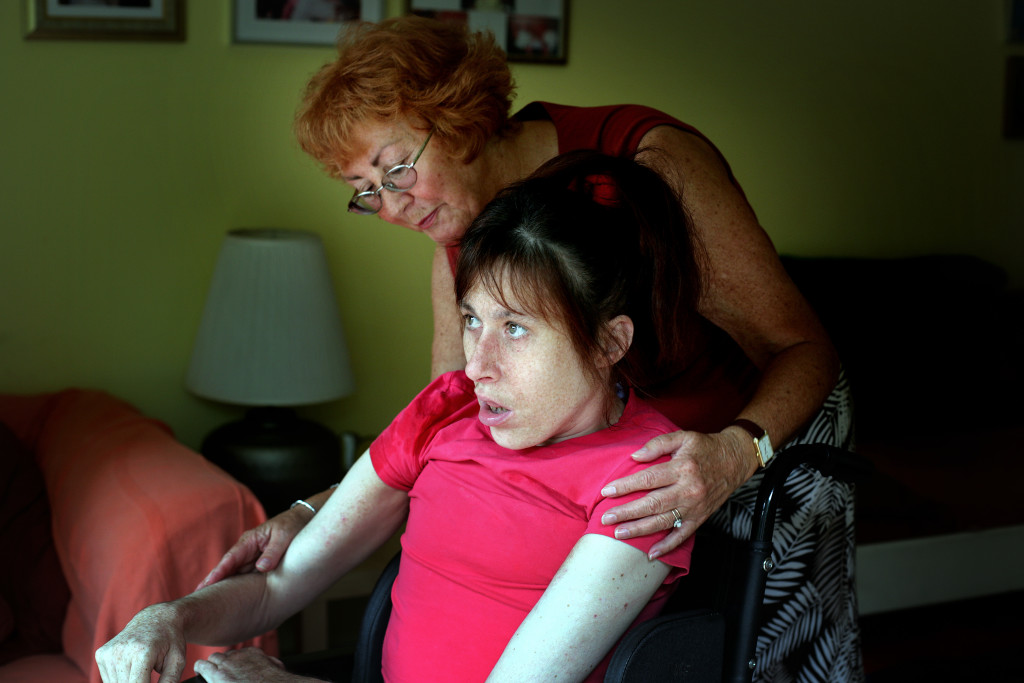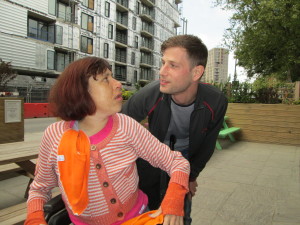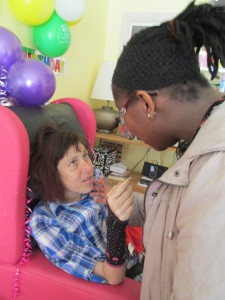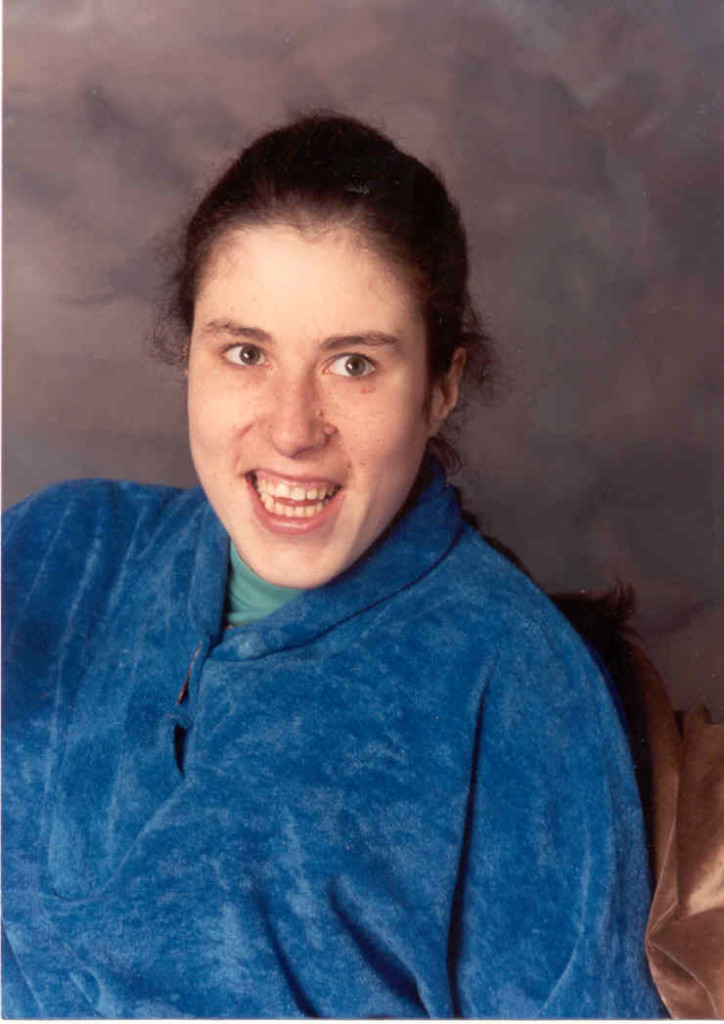Real life stories
Victoria Wilson * Supporting Tim * Keeping Frank at home * Sorting out Patrick’s care * Caring for Patsy
Victoria Willson: a teacher and pioneer
At six months old, Victoria was diagnosed with Tuberous Sclerosis. This affected her brain, skin, and later her kidneys. She had profound physical and learning disabilities, scoliosis, uncontrolled epilepsy, and behaviour which could challenge. She communicated with her eyes, was a full time wheelchair user and was totally dependent on others for all her needs. Throughout her life she had major health problems, often in hospital with critical conditions.
However, she lived an amazingly full and active life, in spite of her disabilities. Victoria was a pioneer, innovator, teacher, activist and actress and a wonderful role model. She had a wicked sense of humour and loved music, food, men, fun and adventures; going to operas, concerts and pubs; and hosting parties in her house.
Victoria’s illness
In 2006 her renal team diagnosed many tiny tumours in her kidneys; and transplant and dialysis were not an option. So began the long process of kidney failure. In 2011 the ELiPSe Palliative Care team entered her life. Her palliative nurse had never worked with people with learning disabilities. The care provider, Centre 404, provided a highly skilled and well-staffed team very able to support someone living in the community. Her parents, sister and two friends were able to demonstrate and articulate just how they wanted Victoria to remain living in her own home.
Everyone had to learn to work together and using a Person Centred approach; good listening skills, reflecting back and being honest it began to work. Initially the Palliative team were surprised by our experience and expectations! We were relieved when we found they could open doors and had the professional ability to apply and get other medics to follow our protocol. For example Victoria would never now go hospital, but could be treated either at home or in an ambulance. Both provider and palliative team followed the family’s wishes.
Together we wrote her End of Life Advanced Care Plan. We all agreed that no radical treatment would be given, and she remained happily in her own home, until she died peacefully on 22 Sept 2014 aged 43.
Who was involved?
Victoria lived safely and happily as a tenant in a house near Kings Cross for 23 years with another disabled woman. They had a 24 hour package of support. Centre 404 was the service provider, and the ELiPSe Palliative team were involved from 2011.
Victoria’s parents, sister, and five of her Circle of Friends were a constant source of support and guidance. For the last two years of her life her mum visited the house most days.
There were many professionals who were totally committed to Victoria continuing to live in her own home. They were her GP, community nurses, physiotherapist; occupational therapist; social services; masseuse, hairdresser and a psychologist who supported her team during the last year.
Care planning
Victoria had the most detailed Health Action Plan, Health Passport, Care Plan and finally Advanced Care Plan. These documents were jointly written by her teams and parents and proved invaluable working guidelines.
As her physical condition deteriorated with her kidneys failing, great care had to be taken with hygiene, eating and drinking, showering, changing and moving her. She developed chronic anaemia, itchy skin and bouts of nausea and diarrhoea. She needed great encouragement to eat and drink and take her medication. Between us we worked together on solutions, i.e. giving crackers before eating, using Aloe Vera for her skin. Her exceptional team became even more patient, inventive and highly skilled
As she grew weaker and more tired, pacing her and her moods was imperative. Now the world came to her, and to keep up everyone’s’ spirits we had themed tea parties and visitors to the house. Together we sought new things for her to experience when she was awake. Her bedroom became an emporium full of smells, sounds, things to look at, and tactile objects to feel. It was made more colourful with fairy lights and flowing silk drapes. Music, her passion, was used to pacify or stimulate and we all became experts in reading her body language.
The end of life
Everyone knew Victoria was dying, but no one knew when. Victoria, always the enigmatic woman, would decide when she had had enough.
For two long years, her and Lisa’s home was always full of marvellous music, fun, love and laughter, with visitors raising their spirits. Visitors told us they were apprehensive about visiting a dying woman, especially one with such profound disabilities. However, all of them left inspired and humbled by the love and care that surrounded our daughter, and Victoria certainly showed enjoyment at seeing guests!
Gradually Victoria’s strength diminished and she came more and more tired and crises were coming more frequently. In the week leading up to her death, many people popped in to say goodbye. Someone was always holding her hand. We all sat in her bedroom, gossiping, drinking tea, telling her what was happening in our world. Very moving moments.
Victoria’s mother describes the last day. On Saturday 21 Sept the Palliative team told us to stop food and drinks, and we, her family knew this would be her last day, and we told her staff and Lisa (her flatmate) to say goodbye. This was so poignant and heart-breaking as each spoke personally and movingly to her. At 11 pm I told my husband and daughter to go home and get some rest. I would stay with Victoria and her night worker. At 3 am with both Emma and I holding her hands, in her own beloved bedroom, surrounded by things she loved, soft twinkling lights, and ‘Namaste’ her Buddhist Monk’s music quietly playing, Victoria died very gracefully and peacefully. Her face immediately lost its pain and grey colour, and once again our much loved daughter became beautiful and at peace. My husband and her sister arrived, we all cried, and said our goodbyes. When the death is good all the pain is forgotten. We three women then washed and dressed Victoria in her specially chosen clothes. This was our last and final gift to her.
It was a colourful pink funeral, with a pink coffin and was a celebration of her life. A staff member, her three friends, a doctor and all her family all spoke. Her favourite music was played. It was held in our local church, which has strong links with our learning disabled community. Over 400 people attended, and everyone wore something pink, orange or red. Vic’s colours.
Victoria’s legacy
Victoria left an extraordinary legacy as a courageous and inspirational young woman, who made us realise what’s possible for people with profound and multiple learning disabilities. She was able to make everyone who met her give her unconditional love; she brought out the very best in people, she made family and professionals work in a team. The amount of love, energy and drive that Victoria inspired around her was undeniable. She taught us patience, tolerance, and some understanding of what it was like to have such a profound disability, and how she made sense of the world, and in doing so we have worked hard to improve the lives of other people with learning disabilities.
It feels to me that Victoria was a pioneer; some of us who were involved in her care had very little previous experience of taking care of such a vulnerable but simultaneously powerful person in the final stage of her life so she was a great teacher who has helped prepare us to care for others in similar circumstances” Palliative Care Clinical Nurse Specialist
Victoria was able to breach the biggest barrier in the disability world and that was to change attitudes. In 2011 Victoria was nominated by Mencap as one of their top twenty inspirational public figures who had made a difference and she became a Mencap Ambassador. She was “the face” of many campaigns of change for people with learning disabilities such as Valuing People, Death by Indifference and Changing Places.
Looking back
“I will always cherish the memory of supporting Victoria in the end stages of her life in both a professional and personal sense. Like her health deterioration, the journey for everyone else wasn’t smooth or ‘by the book’. I remember some emotional and frustrating lows but also some unexpectedly jolly highs. One of the challenges was watching Victoria become less able to go out and do as she pleased but it was also fun creating ways that we could make the day enjoyable if it’s going to be a day in bed or a day without food!” Team Leader
I hope that the workers, who were with her all the time, realise how grateful wider health care professionals were to see the quality of the care that Victoria was in receipt of from them and how impressive their adaptability was as Victoria condition deteriorated. I will always remember a happy, tinfoil and pink feathers laden home where the workers wanted to be there and where the love and protection of the family was always present.” Palliative Care Clinical Nurse Specialist
“Her family look back now with peace and pride in being part of the team that enabled Victoria to live happily and die majestically.” Jean Willson (mother)
“I’ve learned that supporting someone in their death is just, if not more, rewarding and important than supporting them in their life. I’ve also learned the meaning of a ‘good death’ which was a term I hadn’t really heard or understood before. I’ve learned that when it’s my time to go I hope to do so just like Victoria, in the comfort of my own bed with loved ones and fairy lights and music.” Team Leader
“I’ve learned that there are communications that can extend beyond verbal and nonverbal cues – like transmission of a feeling; for months with Victoria I had to rely a lot on people who knew her well for insights and then one day, I got it – she let me see something. It wasn’t that she couldn’t communicate with me, or that I wasn’t able; she took her time to decide whether I was Ok or not. It’s very precious when you get that look.” Palliative Care Clinical Nurse Specialist
Together, her family, her circle of friends, Centre 404 the service provider and the palliative care team gave an outstanding end of life support to Victoria. We now want to continue this work for other people with learning disabilities and their families
Supporting Tim
This is the story of how a dedicated team of staff at Hft Falstaff House in Warwickshire supported a service user with dignity, respect towards his rights of choice during a time of ill health and final stages of his life. The story, told by Jeannette Rix (Area Manager, Hft Arden Vale) won his care home the 2011 Linda McEnhill Award. Read more…
Caring for Patsy
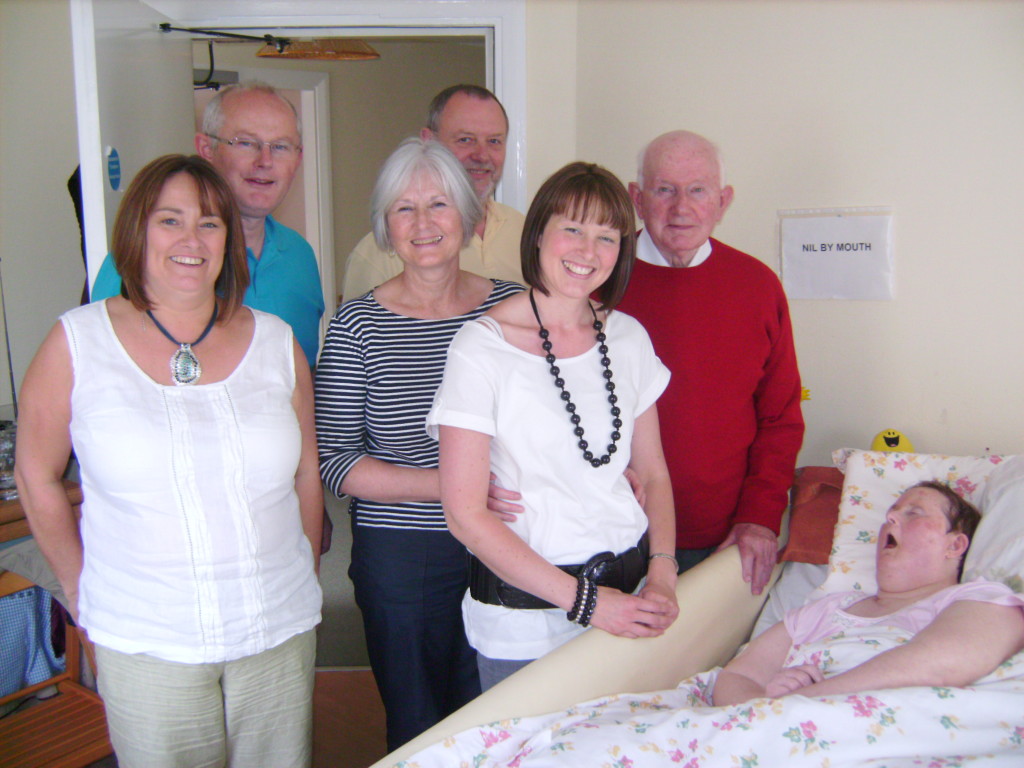
Patsy lived in a nursing home for people with learning disabilities. When she developed dementia, the staff at her home signed up to a national training programme in end of life support. Here, home manager GERARD WAINWRIGHT tells the story that won his team the Linda McEnhill 2010 Award. Read more…
Keeping Frank at home
When Frank was diagnosed with lung cancer, Macmillan Nurse Christine Reddall was called to his care home to offer support. She was impressed by how home manager Lisa Quinlan and her team managed to care for him. Here, she tells Frank’s story: an example of outstanding care. Read more…
Sorting out Patrick’s care
Mark Adams, a Community Learning Disability Nurse, shares his experiences with one of his clients. Patrick Simmons (not his real name) had moderate learning disabilities and lived on his own. Patrick had no family, and relied greatly on professional supporters and a network of friends with similar disabilities. He was active in his local church and had made good friends there. With a robust system of tenancy support and day care, he managed well. Read more…

